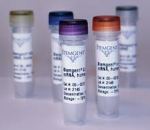Human Newborn Foreskin Fibroblasts (NuFF cells) are genuine feeder cells for Stem cell research. Mitotically inactive NuFF cells (by irradiation or Mitomycin C chemical treatment) can efficiently maintain healthy undifferentiated human pluripotent cell status and support cell reprogramming. In this post, you’ll find the answers to Frequently Asked Questions collected by tebu-bio’s cell biology experts regarding these feeder layers.
I hope these FAQs will help you in your Stem cell research! Have a good read.
Which QC tests are performed on Human Newborn Foreskin Fibroblasts?

Various tests are made to minimize contamination risks and to guarantee robust and consistent cell culture performances. GlobalStem‘s Nuff cells show:
- Negative for bacterial/fungal contamination
- Negative for Mycoplasma (PCR)
- Negative for human pathogens
- >95% post thaw viability
- Sterility (bacterial and fungal) checked
- Identity tested by Short Tandem Repeat (STR) analysis using 16 probes (15 STR loci plus Amelogenin)
- Human pluripotent stem cell culture support guaranteed through multiple passages based on the morphology, growth, and immunocytochemistry of multiple undifferentiation markers
What are the unit sizes of these Human Fibroblasts ?
Whatever the treatment to make them mitotically inactive, GlobalStem’s Human 4M Fibroblast unit size is 4-5 million cells/vial.
- Human Fibroblasts 4M IRR – Newborn Human Foreskin Fibroblasts (NuFF), irradiated
- Human Fibroblasts 4M Mito-C, Mitomycin-C treated Newborn Human Foreskin Fibroblasts (NuFF)
What plating conditions would you recommend for Nuff cells?
The recommended seeding density is 20,000 to 30,000 cells per cm2. Nevertheless, culture conditions might be adapted according to the iPS cells used.
NuFF cells should be plated 24 hours prior to plating the pluripotent cells, and can be used for 7–10 days.
- If the cells are too sparse, they may not maintain the pluripotent cells without differentiation, and the pluripotent cells may not attach well
- If they are too dense, they may detach from the plate, and the culture will be lost
What medium should I use to grow treated NuFF cells ?
NuFFs are expanded in DMEM containing 2 mM glutamine + 15% FBS. Treated NuFF cells should be thawed and plated into the same medium. When using the Newborn Human Foreskin Fibroblasts as a feeder layer, the Stem cell medium can be used when the “stem cells” are plated on the feeders.
How many times can NuFF cells be expanded?
NuFF cells can be passaged to P11 and used to culture pluripotent stem cells.
Cells can be expanded much further, but no tests have been performed above passage 11.
Is it possible to have access to untreated Human Newborn Foreskin Fibroblasts?
Yes definitely. GlobalStem provides untreated Human Fibroblasts NuFF cells (Donor 12; 4-5 million cells/vial) that can be reprogrammed.
Are these NuFF cells compatible with RNA Reprogramming (ex. Stemgent)?

Reprogramming-Qualified NuFF (NuFF-RQ™) feeder cells are compatible with mRNA iPSC Reprogramming (ex. StemGent’s protocol). For this, NuFF-RQ™ IRR cells have been functionally pre-validated and pre-qualified by Stemgent® for optimal feeder layer support during the generation of iPSC colonies.
- Stemgent mRNA Reprogramming-Qualified NuFF (NuFF-RQ™) (Donor 16):
- 4-5 million cells/vial
- Irradiated
- Validation Testing Tested for attachement, mitotic arrest, heath and viability in culture during repeated transfections for the duration of the reprogramming process
- Quality Testing Tested for high efficient maintenance of human pluripotent cells, sterility, human pathogens, mycoplasma, post thaw viability
- Passage Number P6
- Functionally validated by Stemgent-Asterand to support iPS cell colonies from BJ human fibroblasts using the Stemgent’s mRNA Reprogramming Kit
While a range of mitotically inactivated Human fibroblasts can be used as a support layer for pluripotent cell culture, not all will support mRNA reprogramming of patient dermal fibroblasts. NuFF-RQ™ are 100% guaranteed for Stemgent’s RNA cell reprogramming. Browse through Stemgent’s user manual on Stemgent-Asterand’s website for further details.

Any further questions regarding stem cell research?
Various techniques supporting cell reprogramming and iPS cells are now available (ex. small molecules, stabilized FGF2, Activin-A or EGF Stembeads growth factors…). At the end of this post, why not share your experience regarding the way you have been able to boost the efficiency of your cell reprogramming strategies.
You can also leave questions to cell biology experts who’ll get back to you to suggest appropriate solutions and tips!




